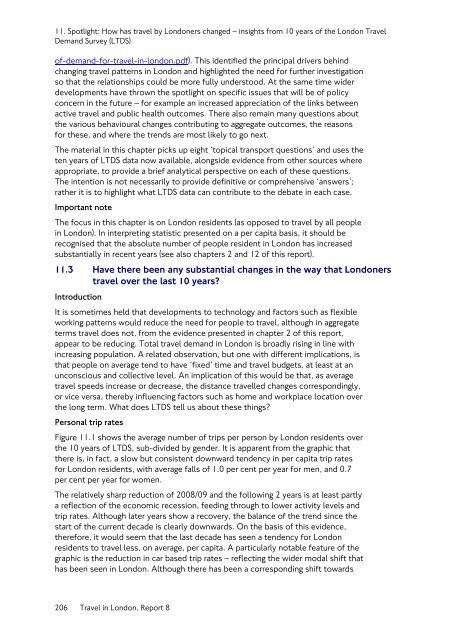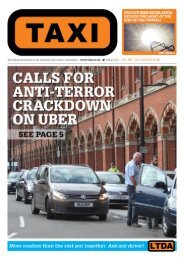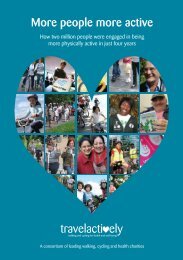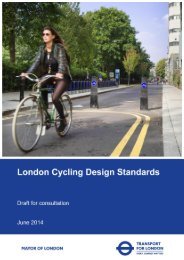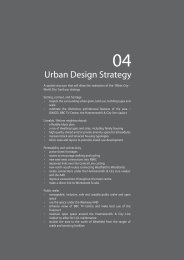Travel in London Travel in London
travel-in-london-report-8
travel-in-london-report-8
Create successful ePaper yourself
Turn your PDF publications into a flip-book with our unique Google optimized e-Paper software.
11. Spotlight: How has travel by <strong>London</strong>ers changed – <strong>in</strong>sights from 10 years of the <strong>London</strong> <strong>Travel</strong><br />
Demand Survey (LTDS)<br />
of-demand-for-travel-<strong>in</strong>-london.pdf). This identified the pr<strong>in</strong>cipal drivers beh<strong>in</strong>d<br />
chang<strong>in</strong>g travel patterns <strong>in</strong> <strong>London</strong> and highlighted the need for further <strong>in</strong>vestigation<br />
so that the relationships could be more fully understood. At the same time wider<br />
developments have thrown the spotlight on specific issues that will be of policy<br />
concern <strong>in</strong> the future – for example an <strong>in</strong>creased appreciation of the l<strong>in</strong>ks between<br />
active travel and public health outcomes. There also rema<strong>in</strong> many questions about<br />
the various behavioural changes contribut<strong>in</strong>g to aggregate outcomes, the reasons<br />
for these, and where the trends are most likely to go next.<br />
The material <strong>in</strong> this chapter picks up eight ‘topical transport questions’ and uses the<br />
ten years of LTDS data now available, alongside evidence from other sources where<br />
appropriate, to provide a brief analytical perspective on each of these questions.<br />
The <strong>in</strong>tention is not necessarily to provide def<strong>in</strong>itive or comprehensive ‘answers’;<br />
rather it is to highlight what LTDS data can contribute to the debate <strong>in</strong> each case.<br />
Important note<br />
The focus <strong>in</strong> this chapter is on <strong>London</strong> residents (as opposed to travel by all people<br />
<strong>in</strong> <strong>London</strong>). In <strong>in</strong>terpret<strong>in</strong>g statistic presented on a per capita basis, it should be<br />
recognised that the absolute number of people resident <strong>in</strong> <strong>London</strong> has <strong>in</strong>creased<br />
substantially <strong>in</strong> recent years (see also chapters 2 and 12 of this report).<br />
11.3 Have there been any substantial changes <strong>in</strong> the way that <strong>London</strong>ers<br />
travel over the last 10 years?<br />
Introduction<br />
It is sometimes held that developments to technology and factors such as flexible<br />
work<strong>in</strong>g patterns would reduce the need for people to travel, although <strong>in</strong> aggregate<br />
terms travel does not, from the evidence presented <strong>in</strong> chapter 2 of this report,<br />
appear to be reduc<strong>in</strong>g. Total travel demand <strong>in</strong> <strong>London</strong> is broadly ris<strong>in</strong>g <strong>in</strong> l<strong>in</strong>e with<br />
<strong>in</strong>creas<strong>in</strong>g population. A related observation, but one with different implications, is<br />
that people on average tend to have ‘fixed’ time and travel budgets, at least at an<br />
unconscious and collective level. An implication of this would be that, as average<br />
travel speeds <strong>in</strong>crease or decrease, the distance travelled changes correspond<strong>in</strong>gly,<br />
or vice versa, thereby <strong>in</strong>fluenc<strong>in</strong>g factors such as home and workplace location over<br />
the long term. What does LTDS tell us about these th<strong>in</strong>gs?<br />
Personal trip rates<br />
Figure 11.1 shows the average number of trips per person by <strong>London</strong> residents over<br />
the 10 years of LTDS, sub-divided by gender. It is apparent from the graphic that<br />
there is, <strong>in</strong> fact, a slow but consistent downward tendency <strong>in</strong> per capita trip rates<br />
for <strong>London</strong> residents, with average falls of 1.0 per cent per year for men, and 0.7<br />
per cent per year for women.<br />
The relatively sharp reduction of 2008/09 and the follow<strong>in</strong>g 2 years is at least partly<br />
a reflection of the economic recession, feed<strong>in</strong>g through to lower activity levels and<br />
trip rates. Although later years show a recovery, the balance of the trend s<strong>in</strong>ce the<br />
start of the current decade is clearly downwards. On the basis of this evidence,<br />
therefore, it would seem that the last decade has seen a tendency for <strong>London</strong><br />
residents to travel less, on average, per capita. A particularly notable feature of the<br />
graphic is the reduction <strong>in</strong> car based trip rates – reflect<strong>in</strong>g the wider modal shift that<br />
has been seen <strong>in</strong> <strong>London</strong>. Although there has been a correspond<strong>in</strong>g shift towards<br />
206 <strong>Travel</strong> <strong>in</strong> <strong>London</strong>, Report 8


